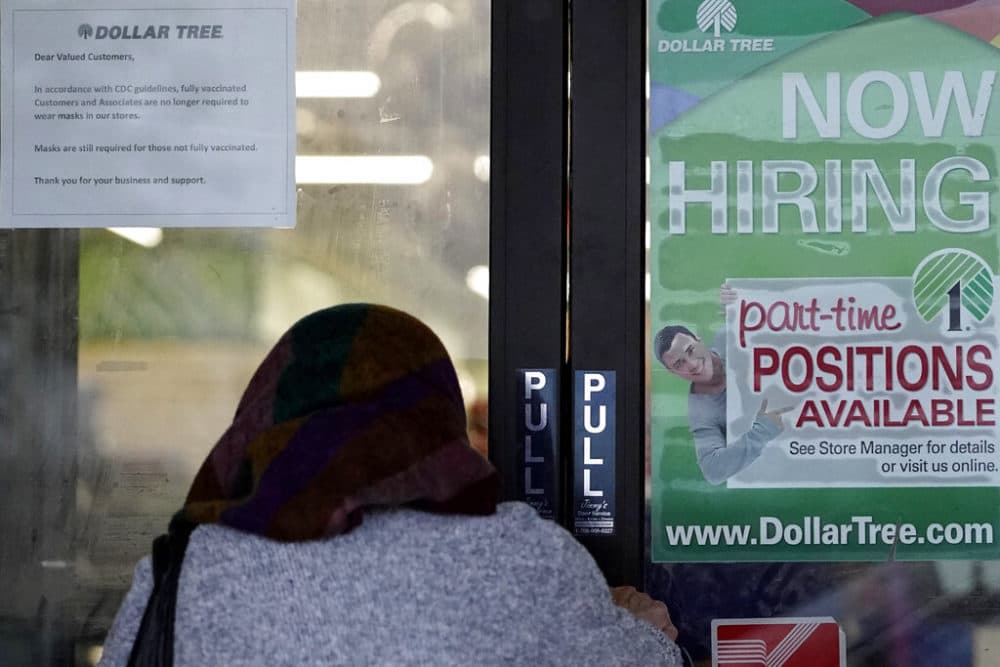Advertisement
The Great Resignation: What's Driving America's Labor Gap
Resume
This rebroadcast originally aired on July 08, 2021.
Something is happening in the workplace. There’s a massive shift in employment numbers — and it has to do with people leaving their jobs. More than 4 million Americans quit their jobs in April. That helped put job vacancies at a 20 year high.
So what’s going on? We ask the Money Ladies — financial columnists Michelle Singletary and Rana Foroohar — about our economy as it emerges from the pandemic. This hour, On Point: Why Americans are saying 'I quit.'
Guests
Rana Foroohar, CNN global analyst. Financial Times global business columnist and associate editor. Author of "Don't Be Evil" and "Makers and Takers." (@RanaForoohar)
Michelle Singletary, personal finance columnist for the Washington Post. Author of "The 21 Day Financial Fast." Her column "The Color of Money" is syndicated in newspapers across the country. (@SingletaryM)
Jennifer Kastelic, she quit her job as a domestic support professional to adults with special needs and disabilities in May.
Interview Highlights
On the increase in Americans quitting their jobs
Michelle Singletary: “What happened with the pandemic, especially in the service industry, many people realize, I don't like this job. I'm not really making a lot of money. And I'm in jeopardy of possibly contracting COVID. And with so much competition, even if they wanted to stay in a similar job, they can look elsewhere for employers who are paying more. I mean, my son, for example, just graduated from college. He's looking for a permanent position. He applied for two jobs, and one was paying him minimum wage. And he is like, forget that.
“And so he's going to go be a lifeguard, which is paying considerably more than a position where he'd be a cashier at a supermarket because, you know, his mama said, you got to get a job. ... But I think that was a real good example of what people are doing. And he's like, listen, I'm going for a job that's going to pay me more, even though that job may not guarantee him the hours that the other one was. But he's pretty confident that he can get the hours. And I think that's it. I applaud those folks who called in and who are saying I am worth more, and this market is showing me that.”
On the history of the current job market
Rana Foroohar: "There's big structural things in play here that have been going on through the pandemic, but also for the last few years. So, if you go back pre-pandemic and really even after the Great Financial Crisis, there were some policy decisions taken that were essentially meant to keep interest rates low, bolster the asset prices. We've talked about that. You know, stocks went up, housing prices went up. But also part of that policy decision, and this was really driven by the labor left, was also to start raising wages at the kind of lower quarter of the socioeconomic spectrum.
"So the Fight For 15, you remember. Real activism around low-paying retail and service jobs, that was all part of this. And indeed, before the pandemic, you were starting to see a tightening of the labor market in those lower paying jobs. And you were even beginning to see certain retailers, Starbucks duking it out with other chains to get the best service workers. So that was happening. Then you have the pandemic. Everything falls off a cliff.
"And what's interesting in this country is unlike some other countries where when things fall off a cliff, you see the state, and the private sector, and politicians and labor coming together to keep people in work, this country does it differently. We simply fire people. You know, we let them go. But the downside of that is it creates these real boom-bust cycles in the labor market where suddenly you have everybody that has left work.
"Some people are getting stimulus payments that tide them over for a certain time. But the companies then have to ramp back up once things start to boom, which, you know, looking around, they really are in many parts of the country now. You have to hire people from scratch. That takes time. It takes money. It creates these choke points, which is what you're seeing now. Companies, all companies, all of a sudden, all at once need workers. That puts labor in a stronger position. And you see people taking advantage of that."
On trends in the labor market
Rana Foroohar: "There's really two trends. There's a short-term trend and there's a longer-term trend. And when I said there was movement, there was movement at the lower end of the spectrum, which, you know, God knows was much needed, because the idea of making a living on $15 an hour is just incomprehensible. So I like the fact that you're seeing wage pressure at the lower end. Just as a quick note, 34% of unemployment right now is people quitting their jobs because they feel confident finding other jobs. So that's one of the things about the June report that I really like.
"But to go back to your point, yes, there is still a huge bifurcation. So you might have people who previously would have made $15 an hour, or $12 an hour being able to get $21 an hour, or $50 an hour in the case of the caller. Although to be honest, let's look at that and say, how many houses can she clean? Can she clean for eight or 10 hours? I'll just tell you one personal story.
"When the pandemic hit and we were unable to have anybody in the house, and my normal lady who helps us cleaning couldn't come, my husband and I said, OK, well, she comes once a week and cleans for 10 hours a day. We're going to divide that between the four of us in our household. We're going to do this. No problem. After about three hours, we all collapsed, exhausted. And I was thinking about how much of a raise I can give her when she comes back, because these are hard jobs. It's not like you're going to be able to work 10 hours a day, seven days a week doing this. So the wage is really, you have to look at it in that context."
Looking to the future of the job market
Rana Foroohar: "We're in what I would call the post-neoliberal world. The last 40 years have been about corporate profits, about cutting costs, about devaluing human capital. Guess what? Human capital is the only thing that matters in the digital economy because it's all about what's in your head, what's in your heart. You know, it's about caring and it's about intelligence. It's about what people can do. And in order to stay ahead of the machines, we've got to start valuing that. So I do think that that's coming down the pike."
From The Reading List
Financial Times: "Creative destruction is the silver lining of the Covid-19 crisis" — "If there is a silver lining to the Covid-19 crisis, it is the remarkable creativity shown by the many businesses that have thrived by transforming themselves in unexpected ways during the pandemic."
Washington Post: "Have a question about the child tax credit? Ask our personal finance columnist." — "On July 15, millions of U.S. families will receive as much as $300 a month per child through the Biden administration’s effort to help families struggling because of the pandemic."
This program aired on September 6, 2021.


